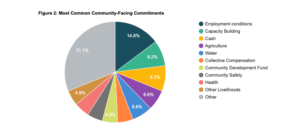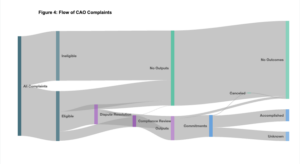Data Doesn’t Support IFC/MIGA’s Remedy Proposal

On February 21, the IFC and MIGA published a long-awaited Proposed Approach to Remedial Action that claims to “articulat[e] a holistic approach” to remedy. However, the proposal is anything but groundbreaking: it concedes to being a summary of IFC and MIGA policies that are already in place, stating that “[m]ost of [the] elements of the proposed Approach are already being implemented […] while others would be enhancements to existing practices.” Oddly, the proposal does not support its stance that existing practices are adequate with any data about what remedy from IFC and MIGA has looked like in the past.
Fortunately, the Accountability Console now includes data on complaint outcomes to help us evaluate how well IFC/MIGA’s remedy efforts have been working. We analyzed the publicly available data from cases to IFC/MIGA’s accountability mechanism, the CAO, and concluded that: (1) although the CAO has facilitated remedy on some occasions (all paid for by clients, as far as we can tell); (2) only a minority of remedial commitments from CAO processes are confirmed to have been accomplished. Unless IFC/MIGA has internal data to the contrary, it appears that the existing approach to remedy is inadequate and should be reevaluated.
CAO processes have produced some remedy in the past.
The Compliance Advisor Ombudsman (CAO) is IFC and MIGA’s primary mechanism for addressing complaints about environmental and social harm caused by its investments. Although IFC/MIGA did not mention any examples in its proposed approach to remedy, publicly available documents indicate that the CAO has facilitated some remedy for project-related harms in the past.
Complaints to the CAO can follow two tracks: (1) the CAO can investigate whether a project complied with the IFC and MIGA’s own environmental and social standards; and (2) the CAO can facilitate a dispute resolution process that identifies ways to address the environmental and social issues. In the compliance investigation track, the IFC or MIGA responds to findings of noncompliance with a management action plan (MAP) that, if designed correctly, includes actions to remediate noncompliance and harm. In the dispute resolution track, IFC/MIGA clients and impacted communities can negotiate an agreement as to what remedy is needed.
We can analyze publicly disclosed MAPs and dispute resolution agreements, as well as reports monitoring their implementation, to identify “commitments” from the IFC, MIGA, or their client to perform remedial actions. A review of all disclosed documents shows that a range of commitments have been made, including (but not limited to) commitments related to consultation, social support, labor, the environment, compensation, livelihoods, and operations management.
According to publicly disclosed monitoring reports, CAO has concluded that 133 commitments have been successfully implemented.

Not all remedial commitments directly address harms to project-affected communities. In fact, most of the publicly available accomplished commitments were changes that IFC, MIGA, or their client promised to make internally: for example, updating operational policies or changing aspects of project design. Slightly under half of accomplished commitments were aimed at addressing the needs of affected community members: for example, provision of social support or compensation.*
Of the community-facing commitments that have been implemented, the most common were changes to employment conditions, capacity building, and cash compensation.

There are at least ten instances, related to five projects, where a CAO process resulted in some form of compensation to communities. In each of these instances, the compensation was paid by an IFC or MIGA client pursuant to a dispute resolution agreement; we found no examples of compensation resulting from compliance investigations.
- Land
- Financing the purchase of new agricultural land for complainants
- Cash
- Cash compensation to farmers whose lands were impacted by a pipeline construction project
- Cash compensation to restore productivity on construction-damaged land.
- Cash compensation for damage to homes during construction.
- Cash compensation to purchase new lands to replace those lost in the development of a hydropower dam, and additional cash compensation to rectify deficiencies in original compensation payments.
- Collective Compensation
- Community compensation for damage due to water runoff
- The provision of supplies to a fisherman cooperative
- Debt-forgiveness for water users in the area
- Other Compensation
- Unspecified compensation to make up for losses in tourism.
Nevertheless, IFC is not adequately delivering remedy for project harms.
IFC and MIGA contend in the proposed Approach that their existing practices are largely sufficient for remediating project harms, requiring only a few “enhancements.” However, this outlook is not supported by the available data, which confirms that remedy for environmental and social harm is exceptionally rare.
For one thing, “accomplished” CAO commitments represent only a small fraction of the total commitments contained in management action plans and dispute resolution agreements. Only 15% of publicly disclosed commitments from compliance reviews are reported by CAO to have been fulfilled, compared to 37% of commitments from dispute resolution agreements. The status of most commitments from both CAO processes is not publicly disclosed.**

Furthermore, just because a commitment is deemed by the CAO to have been “accomplished” does not necessarily mean that the remedy was adequate, or that the affected community was satisfied. Since we don’t yet have comprehensive data on how communities have perceived remedial actions, we are using the CAO’s designation as an approximation.
Why have so few commitments been accomplished? When we looked at monitoring data for in-progress, canceled, and delayed commitments, we saw several recurring factors that had stalled implementation. One of the most common roadblocks was a lack of requisite government support, including insufficient funding.*** We also found that several company parties to dispute resolution agreements cited a lack of capacity as a reason for their failure to fulfill commitments. The fact that these barriers to implementation appeared repeatedly suggests that IFC/MIGA should know that it could improve the delivery of remedial actions by systematically providing direct support for their implementation.
The percentage of cases that are known to have resulted in some remedial action becomes even smaller when we consider that most complaints filed with the CAO never result in any commitments at all. That’s because the majority of complaints never reach the stage of a compliance review or dispute resolution, and therefore do not produce findings or agreements.

While it is likely that some complaints are resolved before the end of a CAO process, or through an alternative mechanism, IFC/MIGA’s proposed Approach provides no information about those cases and whether, or how, remedy was delivered.
Zooming out even further, the total number of complaints filed to the CAO does not represent the total number of instances where IFC/MIGA-supported projects have caused harm to communities. Our work supporting communities to use accountability mechanisms at financial institutions has revealed that many obstacles prevent project-affected communities from filing complaints. These obstacles include language and technical barriers, fear that companies and local authorities will retaliate,**** and lack of awareness that grievance mechanisms exist.***** Therefore, IFC/MIGA’s new Approach should both strengthen the CAO’s accessibility to project-affected communities and enable remedy through channels besides the CAO.
The data in the Console paints a grim picture of IFC/MIGA’s remedial approach to date and shows that the institutions urgently need to reform their current systems. Indeed, IFC and MIGA’s proposed Approach acknowledges that the institutions “can do more” to enable remedy if they are to “build on their leadership in the field of sustainability.” There have been multiple calls****** for IFC/MIGA to stop relying exclusively on clients to fund remedial measures, including from a 2020 external review commissioned by IFC’s board.******* Any serious effort by IFC/MIGA to “do more” should include, as a starting point, committing to contribute to remedy when their investments contribute to harm.
Endnotes
* Notably, none of the cases where CAO facilitated community-facing remedial measures resulted in litigation against IFC. The draft Approach never substantiates its assertion that provision of remedy increases IFC’s risk of legal liability. Conversely, for an example where IFC’s failure to provide remedy through CAO led to litigation, see Michelle Harrison & Shannon Marcoux, Will IFC’s ‘Approach to Remedial Action’ Confront Barriers to Remedy or Dodge Accountability? Lessons from Jam v. IFC (2023).
** If IFC and MIGA could review their non-public records and report on the status of all commitments, this may help us better understand the effectiveness of their remedial approach.
*** Even though IFC/MIGA finances development projects led by private companies, authorization or other support from the local or national government is often necessary for implementing remedial measures (facilitating land transfers, for example).
**** Accountability Counsel & Arab Watch Coalition, Our Last and Only Resort: What Happens When Development Goes Wrong in the Middle East and North Africa (2022); Coalition for Human Rights in Development, Wearing Blinders: How Development Banks Are Ignoring Reprisal Risks (2022).
***** Megan Pearson, Why DFI Clients Should Tell Communities About Accountability Mechanisms (2022).
****** Margaux Day, What Development Finance Institutions Don’t Want You to Know, Devex (2022); Office of the UN High Commissioner on Human Rights, Remedy in Development Finance: Guidance and Practice (2022); Multiple Authors, Glass Half Full? The State of Accountability in Development Finance (2016).
******* External Review of IFC/MIGA’s Environmental and Social (E&S) Accountability, including CAO’s Role and Effectiveness (2020), recommending in part that “[t]wo mechanisms should be established to fund remedial actions: (1) contingent liability funds from the client that can be tapped in the event that E&S harm materializes and is linked to the client’s failure to meet the Performance Standards; and (2) funds that the IFC/MIGA can contribute in the event that IFC/MIGA has/have contributed to E&S harm.”
This article was originally published in the Accountability Console Newsletter, where AC’s team shares research and insights from the world’s most comprehensive database of Independent Accountability Mechanism (IAM) complaints, the Accountability Console. Click here if you would like to subscribe to the monthly newsletter.

